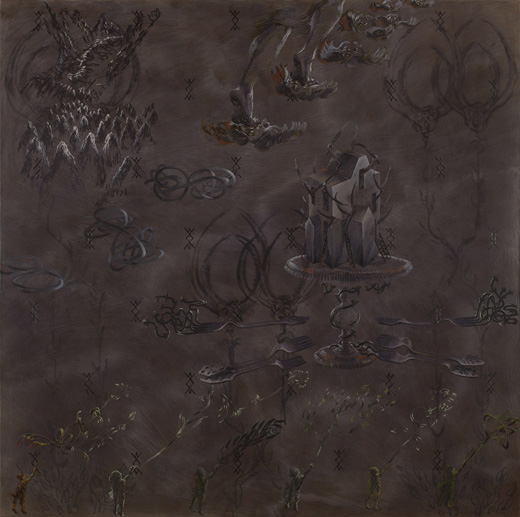
STUTTGART: 6. Juni - 30. Juli 2011
In den Bildern und Skulpturen von Keti Kapanadze verliert die konkrete äußere Welt an Faszination gegenüber der Welt des Subjekts. Die Wahrheit des Subjekts hat immer den Charakter einer Fiktion. Sie ist eine symbolische Konstruktion aus heterogenen Elementen, in der sich Zeugnisse, Zitate und Deutungen des Subjekts mischen. Damit ist die Fiktion jedoch keine bloß „subjektive“ oder „relative“ Wahrheit, sondern sie ist in erster Linie ein Wirken.
Die ambivalente Wirkmacht von Albträumen, Visionen, oftmals des Grauens, verspricht ein poetisches Potential zwischen Angst und Lust, das die Kunst seit jeher beflügelt. Anhand der „Kunstgeschichte des Grauens“ lässt sich feststellen, dass auch diese andere traumatische Welt jenseits der Grenze einer Ordnung unterworfen ist. Diese „Ordnung des Unbewussten“ in der Kunst ist durch Stilmerkmale gekennzeichnet, die mit dem Begriff des Formlosen (Bois/Krauss) verbunden sind. Gemeint ist hierbei nicht die Negation der Form, sondern vielmehr die Bewegung ihrer Auflösung, der Prozess der Überschreitung oder Penetration von Körpergrenzen.
Keti Kapadnazes flächig, ornamental angelegte Malerei erinnert nicht von ungefähr an die Höllendarstellung aus Hieronymus Boschs ‚Garten der Lüste’, in dem die räumliche Ordnung der Welt einer permanenten Orientierungslosigkeit, einem Schweben im Raum weicht. Durch transluzierende Schichten schwirren zeichenhafte Bildelemente, die scheinbar ohne jede Hierarchie, ihres Referenten verlustig, an der Oberfläche einer genuin künstlichen malerischen Welt haften. In der scheinbaren Nähe zum Dekor steckt der Konflikt, denn der Eleganz folgt die Fratze auf den Fuß.
Keti Kapanadze »Der andere Vater« (Engl.)
Painting
In the pictures and sculptures by Keti Kapanadze, the concrete external world loses its fascination in comparison with the world of the subject. The subject’s truth always bears the character of fiction. It is a symbolic construction out of heterogeneous elements in which evidence, quotes and interpretations of the subject interfuse. In this way, fiction is not solely a “subjective” or “relative” truth but first and foremost an effective force.
The ambivalent effect caused by nightmares, visions, and often horror promises a poetic potential between angst and lust that has been firing art since the early days. On the basis of the “Art History of Horror” one can establish that this other traumatic world beyond borders is subject to an order. Within art, this “Order of the Subconscious” is marked by characteristics of style which are connected to the term of the formless (Bois/Krauss). Here, this does not mean negation of the form but rather the notion of its dissolution, the process of exceeding or penetrating the boundaries of the body.
It is no accident that Keti Kapadnaze’s lateral, ornamental way of painting is reminiscent of Hieronymus Bosch’s depiction of hell in “Garden of Delights” where the world’s spatial order gives way to permanent disorientation, a flotation in space. Character-like picture elements adhered to the surface of a genuinely artificial pictorial world – with no obvious hierarchy and forfeiting their instructor – are buzzing through translucent layers. The conflict lies in the apparent closeness to the decor as grimaces are lurking right behind elegance. Text: Parrotta Contemporary Art Gallery.
